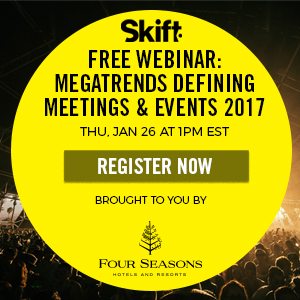Skift Take
Conference organizers are developing more multidisciplinary programming that pulls from both the business and creative industries, creating a new convergence of experiences that help brands plug into business events in more ways.
Last week we released our annual travel industry trends forecast, Skift Megatrends 2017. You can read about each of the trends on Skift, or download a copy of our magazine here.
Download Your Copy of Skift Megatrends 2017
This Megatrend is brought to you in partnership with Four Seasons.
At the South by Southwest Conference & Festival 2016 (SXSW) in Austin, attendees were having two-way conversations with human-looking Japanese robots to showcase the newest innovations in artificial intelligence.
Anthony Bourdain spoke about food, fear, and the future of travel; President Obama called on the civic-tech community to change the world; and Drake and Iggy Pop played to packed, albeit very different, audiences. Swarms of delegates also visited a life-size replica of the Coney Island Ferris wheel where USA Network was promoting its popular TV series Mr. Robot, partially filmed in Brooklyn’s theme park.
The growing convergence between the business and creative industries, as well as boredom with the conference industry status quo, are disrupting how organizations design their conferences to better engage increasingly fractured and distracted audiences.
The festivalization of meetings trend started with the multidisciplinary programming at SXSW and TED, bringing together thought leaders from different sectors to share their views on driving change in a new era of global connectivity. That has since inspired a surge of new “innovation conferences” in cities of all sizes worldwide, ranging from Murmuration in St. Louis to Tech Open Air in Berlin. C2 Montreal, co-created by Cirque du Soleil and the Sid Lee marketing agency, is another cross-pollinating mashup of programming that bridges commerce and creativity (hence the “C2”).
The formula behind these events is generally the same: Pull together the most inspiring minds in business, tech, media, science, education, art, and culture inside a cross-section of colorful venues and collaborative spaces. Then hit “blend” with integrated online and offline catalysts, virtual and augmented reality experiences, startup pitch competitions, live music performances and art exhibits, and local offsite experiences to create spontaneous collisions between participants in unprecedented ways.
The Google I/O 2016 developer conference in California, where Google launches its newest technologies, is a good example of the festivalization of meeting design. Inspired by cult-like events such as Coachella and Bonnaroo, Google I/O 2016 took place for the first time in an outdoor amphitheater next to funky pop-up geodesic domes and stacked shipping containers all shape-shifting from meeting venues in the day to social spaces at night.
The big picture takeaway here revolves around driving higher brand engagement by tapping into both the professional and personal interests of attendees. Meetings have always been platforms for education and marketing, but the blending of live user experiences and human-machine interfaces with previously considered disparate content helps brands plug-and-play into more places with more people at more times. London Technology Week and the Consumer Electronics Show in Las Vegas, for example, have grown into citywide behemoths based on their success as “live-marketing brand experiences.”
So where next? The Freeman event design company created a new Design Leadership Council, with leaders from organizations such as the U.S. Military Cyber Command and Walt Disney Imagineering, to experiment with more diverse convergences between creative environments, new technologies, innovative brands, and visionary people.
“The principle I apply is really to bring wicked teams to wicked problems,” said Bruce Mau, chief design officer at Freeman. “With all the new problems today, you have to think about what’s needed to synthesize all of the content input today to produce a new kind of synthetic media output. It’s not a singular practice anymore. It’s all built by teams, so you need people who are experts at teams.”
Have a confidential tip for Skift? Get in touch


